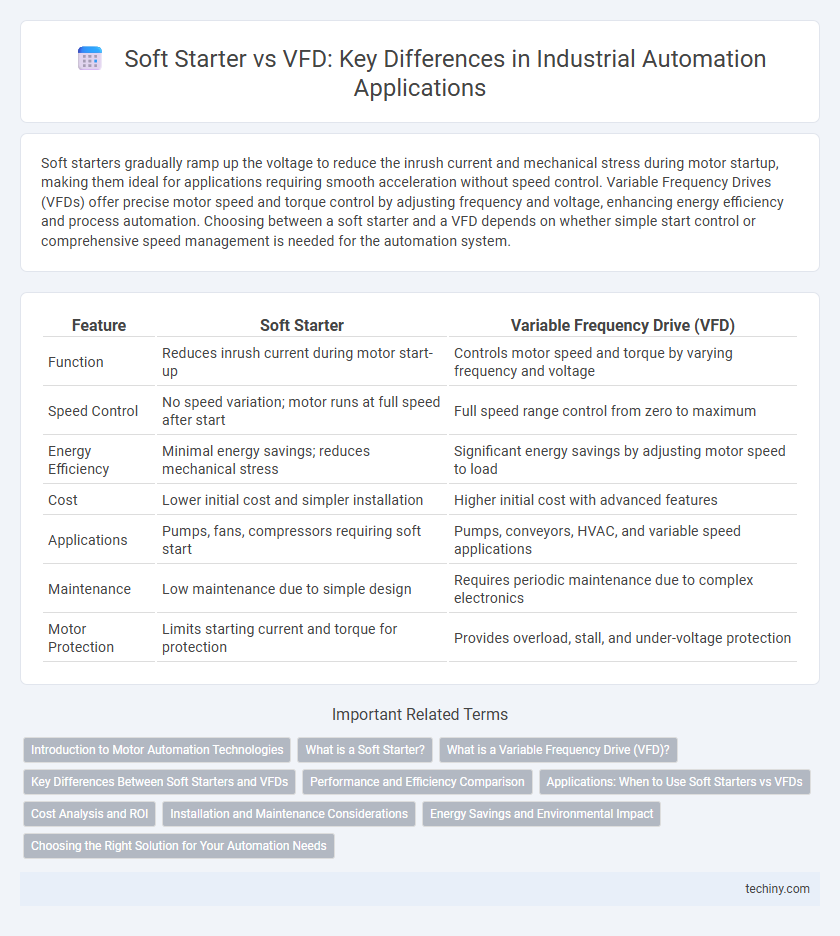Soft starters gradually ramp up the voltage to reduce the inrush current and mechanical stress during motor startup, making them ideal for applications requiring smooth acceleration without speed control. Variable Frequency Drives (VFDs) offer precise motor speed and torque control by adjusting frequency and voltage, enhancing energy efficiency and process automation. Choosing between a soft starter and a VFD depends on whether simple start control or comprehensive speed management is needed for the automation system.
Table of Comparison
| Feature | Soft Starter | Variable Frequency Drive (VFD) |
|---|---|---|
| Function | Reduces inrush current during motor start-up | Controls motor speed and torque by varying frequency and voltage |
| Speed Control | No speed variation; motor runs at full speed after start | Full speed range control from zero to maximum |
| Energy Efficiency | Minimal energy savings; reduces mechanical stress | Significant energy savings by adjusting motor speed to load |
| Cost | Lower initial cost and simpler installation | Higher initial cost with advanced features |
| Applications | Pumps, fans, compressors requiring soft start | Pumps, conveyors, HVAC, and variable speed applications |
| Maintenance | Low maintenance due to simple design | Requires periodic maintenance due to complex electronics |
| Motor Protection | Limits starting current and torque for protection | Provides overload, stall, and under-voltage protection |
Introduction to Motor Automation Technologies
Soft starters and Variable Frequency Drives (VFDs) are crucial motor automation technologies designed to optimize motor performance and energy efficiency. Soft starters reduce inrush current and mechanical stress during motor startup by gradually ramping voltage, while VFDs precisely control motor speed and torque through adjustable frequency and voltage output. Selecting between soft starters and VFDs depends on application requirements such as torque control, energy savings, and process flexibility.
What is a Soft Starter?
A Soft Starter is an automation device designed to gradually ramp up the voltage supply to an electric motor, minimizing inrush current and reducing mechanical stress during startup. It effectively controls the initial torque and current, enhancing motor longevity and preventing electrical disturbances in the power network. Unlike Variable Frequency Drives (VFDs), Soft Starters primarily focus on smooth motor startup without altering the motor's operating speed.
What is a Variable Frequency Drive (VFD)?
A Variable Frequency Drive (VFD) is an electronic device used to control the speed and torque of electric motors by varying the frequency and voltage supplied to the motor. VFDs enhance energy efficiency, provide precise motor control, and reduce mechanical stress during startup compared to traditional methods. Widely applied in industrial automation, HVAC systems, and conveyor operations, VFDs optimize performance and extend equipment lifespan by enabling smooth acceleration and deceleration.
Key Differences Between Soft Starters and VFDs
Soft starters and variable frequency drives (VFDs) both regulate motor startup but differ significantly in operation and control capabilities. Soft starters limit inrush current and reduce mechanical stress during startup by gradually increasing voltage, while VFDs control motor speed and torque continuously by varying frequency and voltage, offering precise process control and energy savings. VFDs provide advanced features like reversible control and acceleration/deceleration ramps, making them suitable for applications requiring variable speed operation, whereas soft starters are ideal for simple starting and stopping with reduced mechanical wear.
Performance and Efficiency Comparison
Soft starters reduce initial inrush current and mechanical stress during motor startup, enhancing equipment lifespan but offering limited speed control. Variable Frequency Drives (VFDs) provide precise motor speed and torque control, enabling energy savings and improved process performance. VFDs typically deliver higher efficiency in variable load conditions than soft starters, which primarily serve to smooth motor acceleration without ongoing energy optimization.
Applications: When to Use Soft Starters vs VFDs
Soft starters are ideal for applications requiring reduced starting current and smooth acceleration in conveyor belts, pumps, and fans, minimizing mechanical stress without altering operating speed. Variable Frequency Drives (VFDs) provide precise speed control and energy savings in applications like HVAC systems, variable torque fans, and centrifugal pumps where variable operational speeds enhance performance. Selecting between soft starters and VFDs depends on the need for speed variability versus simple soft start and stop functions in automation processes.
Cost Analysis and ROI
Soft starters generally offer a lower initial cost compared to variable frequency drives (VFDs), making them a cost-effective choice for applications with simple starting requirements. VFDs provide energy savings and improved process control by adjusting motor speed, resulting in a higher return on investment (ROI) over time despite their higher upfront expense. Evaluating total cost of ownership, including energy consumption, maintenance, and operational efficiency, is critical for optimizing long-term ROI in automation projects.
Installation and Maintenance Considerations
Soft starters require simpler installation procedures with fewer components and lower initial costs, making them ideal for straightforward applications. Variable Frequency Drives (VFDs) demand more intricate wiring, programming expertise, and ongoing calibration, resulting in higher installation and maintenance complexity. Maintenance frequency for VFDs is generally greater due to sensitive electronic parts and cooling requirements, while soft starters offer more durable and low-maintenance operation.
Energy Savings and Environmental Impact
Soft starters reduce energy consumption by minimizing inrush current during motor startup, leading to lower peak power usage and decreased mechanical stress, which extends equipment lifespan and reduces waste. Variable Frequency Drives (VFDs) provide precise motor speed control, optimizing energy use based on load demand and significantly reducing overall consumption compared to fixed-speed motors. Implementing VFDs typically results in greater energy savings and a smaller environmental footprint through reduced greenhouse gas emissions and enhanced operational efficiency.
Choosing the Right Solution for Your Automation Needs
Soft starters provide smooth motor startup by gradually increasing voltage, ideal for applications requiring reduced mechanical stress and simple control. Variable Frequency Drives (VFDs) offer precise speed and torque control, enhancing energy efficiency and process optimization in complex automation systems. Selecting between a soft starter and VFD depends on factors like load characteristics, control requirements, and energy savings goals to ensure optimal performance and cost-effectiveness.
Soft Starter vs VFD Infographic

 techiny.com
techiny.com